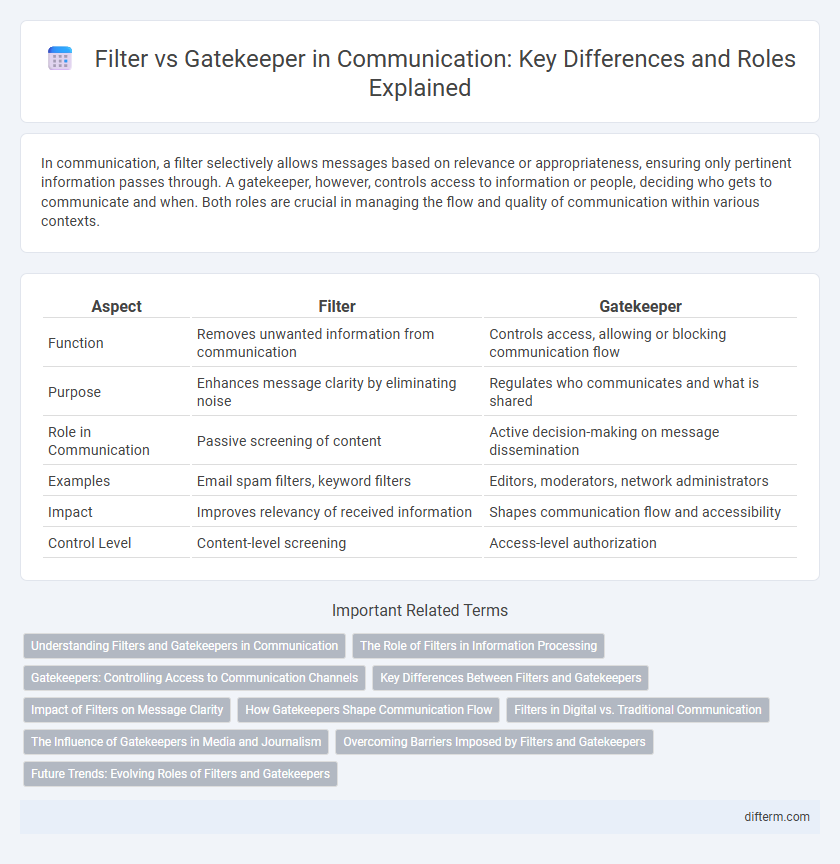In communication, a filter selectively allows messages based on relevance or appropriateness, ensuring only pertinent information passes through. A gatekeeper, however, controls access to information or people, deciding who gets to communicate and when. Both roles are crucial in managing the flow and quality of communication within various contexts.
Table of Comparison
| Aspect | Filter | Gatekeeper |
|---|---|---|
| Function | Removes unwanted information from communication | Controls access, allowing or blocking communication flow |
| Purpose | Enhances message clarity by eliminating noise | Regulates who communicates and what is shared |
| Role in Communication | Passive screening of content | Active decision-making on message dissemination |
| Examples | Email spam filters, keyword filters | Editors, moderators, network administrators |
| Impact | Improves relevancy of received information | Shapes communication flow and accessibility |
| Control Level | Content-level screening | Access-level authorization |
Understanding Filters and Gatekeepers in Communication
Filters in communication refer to the selective process where information is screened based on personal biases, perceptions, or emotions, impacting how messages are sent or received. Gatekeepers control the flow of information by deciding what content passes through to the audience, playing a crucial role in media, organizational communication, and social networks. Understanding the distinction between filters and gatekeepers is essential for improving message clarity and ensuring effective information dissemination.
The Role of Filters in Information Processing
Filters in information processing function to selectively allow relevant data to pass through while blocking extraneous content, enhancing message clarity and reducing cognitive overload. By prioritizing specific criteria such as relevance, accuracy, or source credibility, filters streamline communication channels and improve decision-making efficiency. Unlike gatekeepers who control overall access, filters operate continuously within systems to refine the quality and focus of incoming information.
Gatekeepers: Controlling Access to Communication Channels
Gatekeepers control access to communication channels by regulating the flow of information between sources and receivers, ensuring only relevant messages reach the intended audience. They play a crucial role in media, organizational communication, and social networks by deciding which content is published, broadcast, or shared. This control impacts message visibility, shaping public perception and information dissemination.
Key Differences Between Filters and Gatekeepers
Filters selectively screen information based on predefined criteria, allowing only relevant content to pass through, while gatekeepers control access by deciding which information reaches the audience. Filters primarily manage content quality and relevance, whereas gatekeepers influence the flow and timing of communication. The key difference lies in filters operating as content selectors and gatekeepers acting as access regulators within communication channels.
Impact of Filters on Message Clarity
Filters in communication often distort the original message by selectively emphasizing or omitting information, leading to potential misunderstandings. This selective processing reduces message clarity and can create noise that hampers effective information transfer. Gatekeepers, by controlling the flow of information, further influence clarity by deciding which messages reach the receiver and which are barred, intensifying the impact of filters.
How Gatekeepers Shape Communication Flow
Gatekeepers control the flow of information by deciding which messages pass through communication channels, influencing what content reaches the audience. Their role in selecting, modifying, or blocking information affects organizational transparency and message effectiveness. Understanding gatekeepers helps optimize communication strategies for clearer, more targeted information dissemination.
Filters in Digital vs. Traditional Communication
Filters in digital communication use algorithms and user preferences to personalize content delivery, enabling precise targeting and real-time modification of information flow. Traditional communication filters rely on manual selection and editorial processes, often resulting in slower and less dynamic content control. Digital filters enhance audience engagement by swiftly adapting messages based on behavioral data, whereas traditional filters maintain a more uniform, controlled message dissemination.
The Influence of Gatekeepers in Media and Journalism
Gatekeepers in media and journalism critically shape public discourse by selecting and framing information before it reaches audiences, effectively controlling the narrative. Their influence determines which news stories gain prominence and how events are interpreted, impacting public perception and decision-making. Unlike passive filters, gatekeepers actively evaluate content based on editorial policies, audience preferences, and socio-political factors, reinforcing their pivotal role in communication flows.
Overcoming Barriers Imposed by Filters and Gatekeepers
Filters and gatekeepers often obstruct effective communication by selectively blocking or altering messages based on subjective criteria, limiting information flow within organizations. Overcoming these barriers requires implementing transparent communication channels, fostering open feedback mechanisms, and leveraging technology such as AI-powered tools to ensure messages reach the intended audience accurately and without distortion. Developing training programs that enhance awareness about biases and encourage direct communication can further reduce the impact of filters and gatekeepers in professional environments.
Future Trends: Evolving Roles of Filters and Gatekeepers
Filters and gatekeepers are becoming increasingly automated through AI-driven algorithms, enhancing the efficiency of information management in digital communication. Emerging technologies enable real-time content curation while addressing biases, ensuring more personalized and relevant data delivery. As decentralized platforms grow, these roles shift towards collaborative moderation models, balancing control with user empowerment.
filter vs gatekeeper Infographic

 difterm.com
difterm.com